|

Gleason Industries: A Look Back

Back to Main Gleason History Page
The History of Clay in Gleason
The first clay was dug in 1926, from a testing on the Crawford farm. In a 1928 issue of the Enterprise this account of the clay deposit was given:
On the W.R. Crawford farm two miles west of Gleason, an accident, so the story goes, happened. A tenant on the farm of Mr. Crawford desired to run a cross fence on the farm and, of course, the landlord came out to help locate it. It seems there was a spring on the side of a bluff; and when he examined the spring water, it indicated a clay deposit. He had the place examined and found one of the richest veins of clay ever located in this section. The clay mine took in some twenty acres of the very best variety of clay. Almost overnight the Bell Clay Co. started operation. A large crew of men, some 25, were put to work, and the new find was soon being hauled to Gleason then shipped. The method used to get at the clay was as follows:
Brush was cut and dirt was moved by means of pond scoops pulled by a team of horses. After the dirt was removed, holes were drilled approximately three feet in depth, with hand augers to insert the dynamite. Noah Doran was in charge of the dynamiting. After blasting, workers dug the clay out with picks and shovels, and placed it by hand on the platform. Two Model-T Ford trucks, owned and operated by Alvert Trevathan, hauled the clay to what was called the "gin" siding on the railroad north of town, where the offices of Bell Clay Company were located in later years. Ivo Edmonston was in charge of moving the dirt. Some of the other workers were Fate Vaughn, as Supervisor and co-owner with Bell, Wade Parks and Carlos Trentham. The best variety of clay always had a layer of lignite between the dirt and clay.
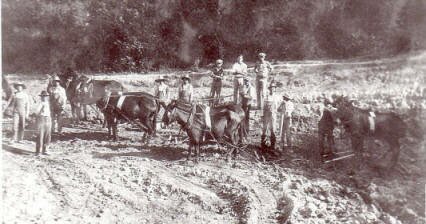
Kelly Finch discovered clay on his land in 1927. He was digging a square wooden curbed well to water his livestock when he hit clay and had difficulty digging further. Mr. Finch was an inquisitive man, so he drilled test holes to find the extent of the mineral on his farm. Satisfied that there was minable clay, he proceeded to open a mine with seven or eight teams of two mules to a pond scoop. At about this time he started for Zanesville, Ohio, with a suitcase full of clay samples for testing. On the way the train porter, a former employee of the Spinks Clay Company, picked up the heavy suitcase, and upon finding what the contents were, suggested that Mr. Finch go to Cincinnati, home of the famous Rockwood Pottery. Upon arriving in Cincinnati, the clay was tested and found to be superior in quality. Spinks Clay Company started to mine the land in 1930.
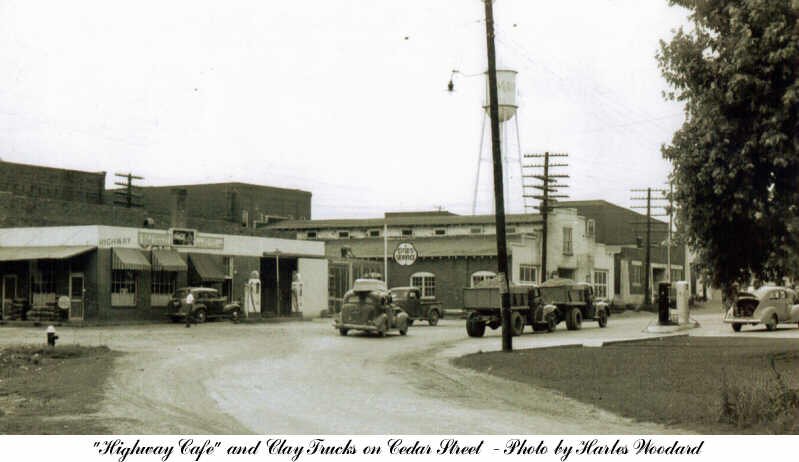
The clay industry continued to grow until, in 1970, there were five clay mining companies whose combined daily shipment totaled 600 tons of clay. A sign erected on the edge of Gleason's city limits reads:
"Welcome to Gleason, Ball Clay Mining Center of the Nation"
This mineral has its richest and greatest deposits here in West Tennessee - and especially in Weakley County.
Since this clay is of the finest grade, it is used in making a very find grade of china and porcelain ware, as well as pottery. This is a very brief history of the mining of clay in Gleason since its discovery in 1926 to the present. There are currently four clay mines operating: Old Hickory, Kentucky-Tennessee, Spinks, and Cypress.
THE BRICK INDUSTRY
Around 1910, a brick plant was established by several local businessmen on the Charlie Overton land near the corner of Jeans Mill road and East Union streets. Bricks were made there and used to build a number of buildings that are still standing, including the old corner store building (next to City Drug Store), the Dr. Jeter house, the E. L. Lemonds house (both on College street.), the Jeff Parks house on West Street, and the Will Malone house (now Harvey Morris' house) on Hopewell street.
Gleason Clay Products, a subsidiary of Bush Brick of Nashville, was established on the old Dresden Highway in 1960. In 1986, it became the Gleason Brick Division of Merry Company of Augusta, Georgia. It is a part of the largest brick manufacturer in the world, Boral Industries Incorporated of Australia. The local plant currently employs eighty-one people and manufactures a daily average of 164,736 bricks.
THE Gleason Foundry
In 1933, the Gleason Foundry Company was established as a partnership by W. F. Trevathan, Ellis F. Trevathan, and J. T. Forrest (who claimed to be a direct descendent of Nathan Bedford Forrest). It was for the manufacture of grey iron, brass and aluminum castings. They supplied, among others, castings for narrow-gauge rail equipment used in the local ball clay mines in West Tennessee and Kentucky.
During the mid-thirties, the Gleason Foundry became involved in the development of clay shedding equipment for the local clay industry. This has continued and grown considerably and consistently through the years.
In the early days of World War II, the casting operation was suspended. It was never re-established due to the fact that after the war Gleason Foundry began to manufacture the Gleason Shredder in its earliest configuration; some of the basic designs of which are incorporated into the present day models. Their history has been one of continuous experimentation, research, and development in an effort to produce the most efficient, versatile, and maintenance-free reduction unit possible. These clay shredders are sold nationwide as well as in a number of foreign countries.
Gleason Foundry was incorporated in 1966. In 1987 Ellis Frank Trevathan serves as Chairman of the Board, and his son Frank Trevathan serves a President. They currently have twelve employees.
Gleason's Post office
Gleason's first Post Office was established in 1851 in a corner of John Hamilton's general store. He was the first Postmaster and remained in that capacity until the summer of 1861.
The second Post Office was located under the hotel building until 1936 when it was moved to the corner building previously occupied by the Farmers and Citizens Bank and Hawks Cafe (where the Resale Shop now is).
In 1939, a large modern Post Office building was erected at 101 Cedar Street at E. Main. The reason a community the size of Gleason has the large Post Office building is in large part due to the sweet potato plant business whose shipments increase the volume of mail handled through the Post Office.
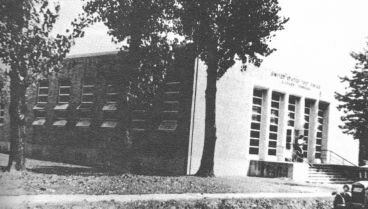
The list of Postmasters from 1851 to the Present (1986) include:
The list of Acting Postmasters includes:
-
Kathleen Wright
-
Pete Taylor
-
Toby Bell
-
Lewis Terrell
Bob S. Wray is the present (1986) Postmaster, having been appointed in 1961.
THE Old Depot
In the 1913 and 1914 issues of the "Gleason Herald", the following timetable for Eastbound and Westbound trains on the N. C. and St. L. Railroad was scheduled.
| # 1 Dixie Flyer 5:07 A.M. |
# 2 Dixie Flyer 11:27 P.M. |
| # 3 Dixie Flyer 4:25 P.M. |
# 4 Dixie Flyer 11:29 A.M. |
| # 53 Dixie Flyer 2:42 P.M. |
# 52 Dixie Flyer 5:15 A.M. |
| # 55 Dixie Flyer 9:04A.M. |
# 54 Dixie Flyer 6:36 P.M. |
All trains were met by local citizenry for the fellowship and to see who was arriving and departing. Even church services were dismissed for the noon trains. At this time W. V. Overall was the Depot agent.
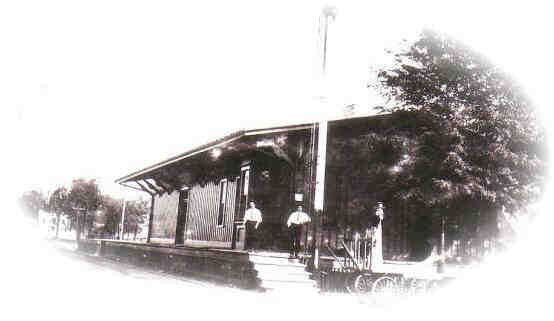
In the 1913 and 1914 papers, N.C. and St. L. railroad advertised a round trip to Nashville for $2.00, so when planning your summer vacation, don't overlook any of the following low fares:
|
Round Trip Martin to Chicago, Illinois $18.00
Round Trip Martin to Louisville, Kentucky 11.30
Round Trip Martin to Cincinnati, Ohio 16.30
Round Trip Martin to St. Louis, Mo. 9.50
Round Trip Martin to New York City, N.Y. 40.30
|
Another advertisement in the May 23rd, 1913 Herald advertised:
"Let's Everybody Get Ready to Give the Nashville Boosters a Big Blow-out When They Arrive Here." This will not only boost our little town, but will be quite a treat for all to see them and their fancy train.
Some of the early agents were Tom Cooper, Tom Butler, W. V. Overall, and Mr. McDonald. A familiar sight in the twenties and thirties was Marion Gibbs, a much loved black man, pushing the small mail cart from the trains to the Post Office. Also Leonard Brawner picked up packages at the Depot and delivered them around town for $0.25 per delivery.
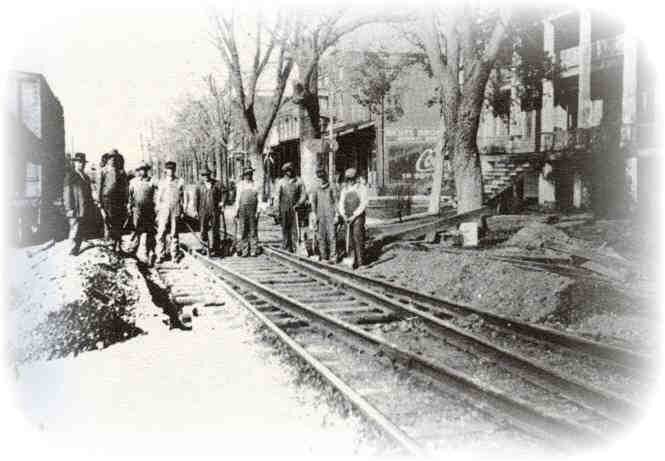
Section hands working on railroad in front of the Whitworth Hotel in the early 1920's
The Depot was torn down in 1970 or 1971, much to the displeasure of many of us who had fond memories of the time spent there. A metal building was moved onto the site to do railroad business, with L. L. Bennett as Agent. Following Mr. Bennett's retirement, other agents who took over were Mr. Rogers, Mr. Sylvis, and Frank Cequin.
The metal building was removed in 1984, since Gleason no longer had a through train to Dresden. The few freights which run through the town each week only go to the Clay companies and to Krueger-Ringler where they turn around.
Telephones in Gleason
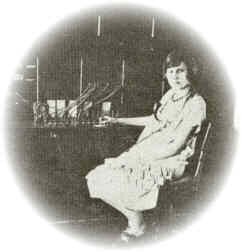 The Rural Telephone Company, nicknamed the p-vine, had its switchboard upstairs over the Farmer's and Citizen's Bank on the corner of Front and Main streets facing the railroad. From 1908 to July 1912, Clarence and Bulah Horn lived there in full charge of the switchboard, repairing lines, etc. at a salary of $35 per month paid by George Brummitt, with A. W. Carroll as Secretary. Others who operated this telephone system were J. Cleatus and Zela Trevathan, Ambus and Willie Stoker, Jenny Taylor, Florence and J. R. Kelly, and Louisa Stigall. The Rural Telephone Company, nicknamed the p-vine, had its switchboard upstairs over the Farmer's and Citizen's Bank on the corner of Front and Main streets facing the railroad. From 1908 to July 1912, Clarence and Bulah Horn lived there in full charge of the switchboard, repairing lines, etc. at a salary of $35 per month paid by George Brummitt, with A. W. Carroll as Secretary. Others who operated this telephone system were J. Cleatus and Zela Trevathan, Ambus and Willie Stoker, Jenny Taylor, Florence and J. R. Kelly, and Louisa Stigall.
The Cumberland Telephone System was located over Fowler's Grocery and the Brundige Produce Building (where Gleason Hardware and Appliance is now located). Some operators of this system were Mattie Buntin, Mable and Mack Smyth, Zelphur Steward, Vergie Sims, and Lubie Stalcup.
\
In the 1950's, Southern Bell installed a dial system, when Jess Margrave was Mayor. In 1960, direct dialing or 1 plus was introduced to Gleason Residents. The switchboard was located in the Margrave building on Cedar Street. A new telephone building to house the dialing equipment, was build by South Central Bell in the 1970's on Jeans Mill Road. [Scroll down for story about Hugh Gordon Stoker, of the famed Jordanaires and his early beginnings in the Gleason Switchboard office.]
Electricity in Gleason
Electricity came to Gleason in 1916, and Clarence Horn operated the first light plant, which was located on the old hitching lot. The current was only turned on one day per week and certain hours at night.
The Gleason Opera House had electricity which they got from privately installed dynamos across the street. The Opera House was located on the second floor over the Ammon's Drug Store and seated 400 people. Touring stock companies appeared here, with the outlaw, Cole Younger, once a guest. Moving pictures were shown there three time a week.
Gleason is now served by Weakley County Municipal Electric System with main offices in Martin, Tennessee.
The Funeral Business
Mr. John Shipley was the first Undertaker known of in this area. He started his business sometime in the early 1900's. He had a store building on Main street, near Gleason Hardware, where he stored the caskets. Bodies were prepared and kept in the homes of the families until funeral time. Rob Cravens drove the grey horses that pulled the hearse. It was also Mr. Shipley who later had the first motor ambulance here. In front of his building, his wife, Mattie, had a millinery shop. The Shipley's lived in a house where the Lucille Smyth home now stands.
In about 1920, S. D. (Sam) Summers (who was also the local Veterinarian) moved to Gleason with his family where he continued to live and practice until he was disabled in 1940 and Ned Castleman went into the undertaking business. It was called the Gleason Undertaking Company. The hearse was pulled by a pair of beautiful white horses. After several years they bought a motor hearse which also served as an ambulance. It was driven by Sam Summers' son, Leon Summers. In later years the business was continued with Dr. Dave Terrell as a partner. George Barrix also assisted in the business.
In 1935, F. L. Maddox began his career in the Undertaking business. He first managed the business for Winstead and Jones, who had an office in Gleason. Later, they sold the business to Bowlin and Riggs of Dresden (Jim Bowlin and M. F. Riggs) and managed by F. L. Maddox.
In the 1940's, F. L. Maddox and his brother, J. H. Maddox, became partners with Bowlin and Riggs. At that time F. L. Maddox became General Manager of Maddox and Company Burial Association. Some of Mr. Fitz's employees were Warren Maddox, Joe Willard Aylor, Jewell Simms, and Jewel Phelps. He continued in this position until his health forced him to retire in 1964. At this time S. T. Bowlin bought the business and combined it with Bowlin Mortuary of Dresden.
Ridgeway Morticians, Ridgeway Funeral Home, came to Gleason in 1962 and located in the building next to the Gleason Public Library. Mayo Gallimore served as manager. In 1965, Ridgeway erected the present building, built by Claude Williams and Ginis Vinson, which is located on the old McKenzie Highway at the edge of town. In 1968, Mayo Gallimore bought the funeral home from Ridgeway (John Ridgeway) and it became Gallimore Funeral Home.
Karen Gallimore House followed in her father's footsteps and graduated from Mortuary College in 1976. After Mr. Gallimore's death in 1977, Karen and her mother, Sarah Gallimore, became partners in the business. Present employees of the Gallimore Funeral Home include; Sarah Gallimore, Karen Gallimore House, Funeral Director and Embalmer: Robert E. Highfill, Funeral Director and Embalmer: Al Cox; and Clifford Moody and Leslie Hudson, grave diggers.
The Sweet Potato Plant Business
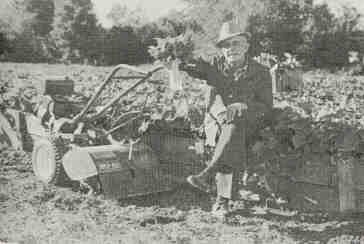 Gleason is know as the sweet potato capital of the United States, and the town proudly carries the nickname, "Tater Town." The plants grown in Gleason are shipped all over the United States with an occasional shipment as far away as Hawaii. Gleason is know as the sweet potato capital of the United States, and the town proudly carries the nickname, "Tater Town." The plants grown in Gleason are shipped all over the United States with an occasional shipment as far away as Hawaii.
The growing and shipping of sweet potato plants in Gleason began back in the 1920's. In the beginning there were only a few shippers or dealers in the sweet potato plant business. In addition to the dealers who all grew plants, many farmers in the area grew plants which they then sold to the plant dealers for shipment. Now, most of the farmers have stopped growing the plants and the dealers grow their own. The sweet potato plant dealers got most of their customers by advertisements run in farm magazines.
In the beginning there was only one variety of sweet potato plants grown in Gleason. That one variety was Nancy Hall. In the late 1920's, however, two friends of J. D. Bradberry asked him to join with them in ordering some sweet potato plants from Puerto Rico to be grown for shipment. The first plants produced potatoes that were firm but not too pleasing to the taste. The men decided to graft some of the Puerto Rican plants with Southern Yam plants. This combination produced a potato that was firm as well as pleasing to the taste. The next step was to find a name for the new potato plant. Some of the names proposed for the new variety were: Porto Rico-southern yam, Porto Rico-yam, or Porto Rico and ______. The name finally agreed upon was Porto Rican. The only place in the world a Porto Rican plant could be purchased was Gleason, Weakley County, Tennessee. As time went by, several other varieties of plants were developed until, at the present time, there are some ten to twelve different varieties grown in the area. Steele Plant Company has worked closely with experimental stations testing two new varieties of sweet potatoes. These varieties are the Vardaman, a vineless variety with purple foliage, and the Georgia Jet, an orange fleshy potato with purplish red skin which produces an extra high yield.
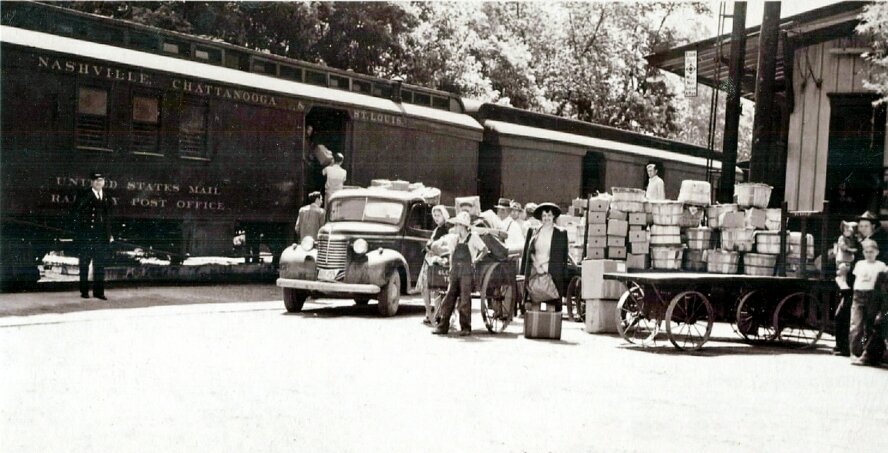
Sweet Potatoes Shipped by Railroad
Picture Note 1:
Young boy in white shirt (right) - Jimmie Glenn; Man standing on platform - Gale W. Ray; Lady with suitcase - Rachael Kennon, Man on left side of Truck - Harry Mac Edwards.
Picture Note 2:
Picture made by Marie and Calvin Wheat, developed by Harles Woodard (Gleason, TN), received from Laurie Beach Pine, and provided to www.GleasonOnline.com by Jimmie Glenn.
------------------------------
Over the years there have been approximately thirty different individuals operating as plant shippers in Gleason, but some of these have retired, some have sold out, some have quit, and some have passed away. Today, there are only two companies in Gleason still shipping plants. They are the Steele Plant Company, owner Dudley Sanders, and Margrave Plant Company, owner Frank Margrave. The sweet potato business has provided seasonal jobs for numerous people in the Gleason area and, of course, put money into the overall economy of our town.
For many years our plants were shipped by Parcel Post and Railway Express. In addition to this, quite a few plants were shipped by truckloads and many peddlers from different areas came here to purchase plants. Many large orders for 50,000; 100,000; or, on a rare occasion, 1,000,000 plants were filled. Of course, the passenger trains were running when the plants were being shipped by Railway Express. Also, the Parcel Post shipments were sent from the Post Office to the railroad station to be transported by the passenger trains. Many times there were so many plants at the station ready to be loaded on the train that the train would have to sit in Gleason for as long as 30 to 45 minutes for the plants to be loaded.
Passenger trains stopped running through Gleason a number of years ago, and the plants are now shipped almost entirely by Parcel Post and United Parcel Service. The Parcel Post shipments are picked up by U.S. Mail trucks every week-day, and the United Parcel Service trucks pick up the plants here five days per week --- Monday through Friday. Gleason "Growers of Potato Plants" believe that they started something. One result in evidence is Gleason's United States Post Office. The tiny third-class post office became a beautiful second-class post office, because of the sweet potato business in this area.
The method of doing business has changed to where Gleason Plant Dealers do not even try to get large orders anymore, but make and effort to get as many small orders as possible. However, it is believed that there are still more mail order sweet potato plants shipped out of Gleason each year than from any other town in the nation.

The history of the Gleason community provided in Oakwood-Gleason: A Look Back provides an account of Gleason's history up through the time the book was originally published. As some 20 years have now passed since its publication, Gleason Online is providing a "History Update" feature, for each section of the book, for those wishing to add important historical information relevant to the Gleason community. Contributions can be submitted via E-mail attachment by clicking on the "Website Visitor Comments" graphic, provided above.

Historical Note: Gordon Stoker and the Gleason Switchboard
Hugh Gordon Stoker of the Country Music Hall of Fame Jordanaires, began his musical career at age eight at Tumbling Creek Baptist Church, just outside of Gleason. In citing the early influence of his parents, mom Willie and dad Ambus (known in Gleason as H. A. Stoker), he states that he was born on August 3, 1924 right in the middle of Gleason. The place of birth was the old telephone office building where his family lived. As he tells it, his mother was one of two switchboard operators for the telephone system and his father was the repairman.
He indicates that his mother was the night time operator, and that "You couldn't make a phone call after 9:00 p.m. or before 6:00 a.m."
He goes on to indicate that incoming phone calls were completed by means of a "switchboard" that connected the lines between caller and receiver and notes that calls made after an hour that was unacceptably late for phone calls were either not answered or met with the announcement, "It's after 9:00 p.m." He admits that "Maybe if it was somebody she knew, she would go ahead and connect them." Gordon's collection of memorabilia includes an old crank telephone once worked on by his father. Source: Jordanaires.net.
J. Johnson

[Back]
Home About Us About Us Gleason Businesses Gleason Businesses Churches Churches Gleason School Gleason School Obituaries Obituaries Pictures Pictures Gleason News Gleason News Contact Us Contact Us
Copyright © 2003 - 2007 www.GleasonOnline.comTM. All rights reserved.
|